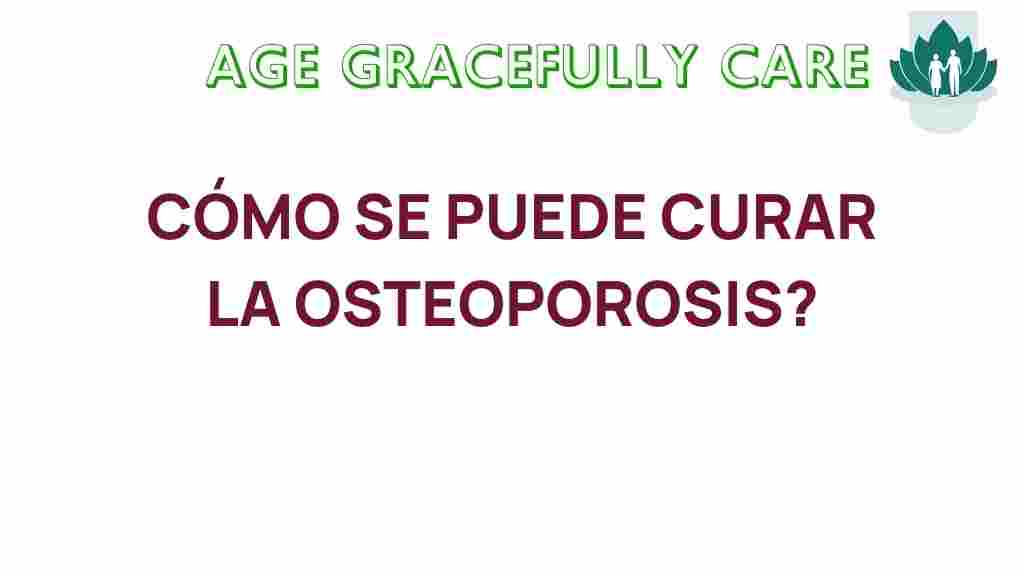Unlocking the Secrets: How Can Osteoporosis Be Reversed?
Osteoporosis is a silent condition that weakens bones, making them fragile and more likely to fracture. As we age, understanding how to improve bone health becomes crucial, especially for those at risk. While osteoporosis is often seen as a one-way street, recent advancements in medical research suggest that it may be reversible. In this comprehensive guide, we will explore the prevention, treatment options, and lifestyle changes that can help improve bone health and potentially reverse osteoporosis.
Understanding Osteoporosis
Osteoporosis is characterized by low bone mass and deterioration of bone tissue, leading to an increased risk of fractures. It affects millions of people worldwide, particularly postmenopausal women and older adults. Understanding the risk factors is essential for prevention and treatment.
Risk Factors for Osteoporosis
Several factors contribute to the development of osteoporosis, including:
- Age: Bone density decreases naturally with age.
- Gender: Women are at a higher risk, especially post-menopause.
- Family History: A family history of osteoporosis can increase your risk.
- Body Frame Size: Smaller body frames tend to have a higher risk.
- Hormonal Levels: Low estrogen levels in women and low testosterone levels in men can affect bone health.
- Diet: Low calcium and vitamin D intake can weaken bones.
- Physical Activity: Sedentary lifestyles contribute to bone loss.
Unlocking the Secrets to Osteoporosis Reversal
Reversing osteoporosis involves a multi-faceted approach that includes prevention strategies, effective treatment options, and significant lifestyle changes. Here’s how you can take action:
1. Nutrition for Strong Bones
Nutrition plays a vital role in maintaining and improving bone health. Here are key dietary components:
- Calcium: Essential for bone formation. Aim for 1,000-1,200 mg daily. Sources include:
- Dairy products (milk, yogurt, cheese)
- Leafy greens (kale, broccoli)
- Fortified foods (cereals, orange juice)
- Vitamin D: Helps the body absorb calcium. Get 600-800 IU daily from:
- Sunlight exposure
- Fatty fish (salmon, mackerel)
- Supplements if necessary
- Protein: Important for bone health, aim for adequate intake through:
- Lean meats
- Legumes
- Nuts and seeds
- Magnesium and Vitamin K: These nutrients are also essential for bone health, found in:
- Whole grains, nuts (magnesium)
- Leafy greens, fermented foods (vitamin K)
2. Exercise: The Key to Bone Health
Regular physical activity is crucial in preventing and reversing osteoporosis. Weight-bearing and resistance exercises can strengthen bones and improve overall health. Here are some effective types of exercise:
- Weight-Bearing Exercises: Activities that make you work against gravity, such as:
- Walking
- Jogging
- Dancing
- Stair climbing
- Resistance Training: Using weights or resistance bands to strengthen muscles, which in turn helps bones.
- Balance and Flexibility Exercises: Yoga and tai chi can help prevent falls by improving balance.
3. Medical Advancements in Osteoporosis Treatment
In recent years, advancements in medical treatments have provided new options for those with osteoporosis. Here are some treatments to consider:
- Bisphosphonates: Medications that help prevent bone loss and reduce fracture risk.
- Hormone Replacement Therapy (HRT): Can be effective for postmenopausal women to maintain bone density.
- Bone-building medications: Such as teriparatide, stimulate new bone growth.
- Monoclonal antibodies: Like denosumab, which help increase bone mass and reduce fractures.
Consulting with a healthcare provider is essential to determine the best treatment plan based on individual needs and medical history. For more detailed information on osteoporosis medications, visit this resource.
4. Lifestyle Changes for Osteoporosis Prevention
Making significant lifestyle changes can greatly impact your bone health. Consider the following:
- Quit Smoking: Tobacco use is linked to lower bone density.
- Limit Alcohol Consumption: Excessive alcohol can interfere with calcium balance.
- Maintain a Healthy Weight: Being underweight increases the risk of bone loss.
- Regular Check-ups: Monitor bone density and overall health with your healthcare provider.
Troubleshooting Tips for Osteoporosis Management
Managing osteoporosis requires ongoing commitment and adjustments. Here are some troubleshooting tips:
- If you struggle with diet: Consider working with a nutritionist to create a bone-healthy meal plan.
- If exercise feels overwhelming: Start with short, manageable sessions and gradually increase duration and intensity.
- If you experience side effects from medication: Discuss alternatives with your healthcare provider.
- If you have frequent falls: Assess your home for hazards and consider physical therapy for balance improvement.
Conclusion
Reversing osteoporosis is not just a dream; it is an achievable goal through a combination of nutrition, exercise, medical treatments, and lifestyle changes. By understanding the risk factors and taking proactive steps towards prevention and treatment, individuals can significantly improve their bone health and quality of life. Remember, it is essential to consult with healthcare professionals to tailor a plan suitable for your specific needs. Embrace the journey to stronger bones and a healthier future!
For more information on osteoporosis and its management, check out this informative article.
This article is in the category Health and created by AgeGracefullyCare Team
